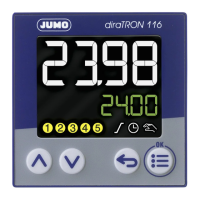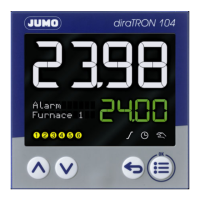25
5 Noncyclical data exchange
Data exchange sequence for data exchange packets in the "Single-ID" and "Multi-ID" formats
With JUMO IO devices, the noncyclical data are not directly accessed via the "WRREC" and "RDREC"
PROFINET IO function blocks. Instead, data exchange packets that are processed by the IO device are
transferred. The IO controller has to write a data exchange packet with query data to the JUMO IO device
(WRREC). JUMO IO devices accept the data from the data exchange packet and then prepare this pack-
et with response data for the IO controller. The IO controller must pick up this data exchange packet with
response data again (RDREC). The data exchange packets in the "Single-ID" format can be used to
transfer single data points within a data exchange sequence. The "Multi-ID" format can be used to trans-
fer up to 4 data points within a data exchange sequence. This requires a suitable sequence control to be
implemented in the IO controller.The sequence control of a data exchange sequence in the "Single-ID"
and "Multi-ID" formats can be designed as follows:
Sequence control of a data exchange sequence for single-ID data exchange packets
1. Parameterize data structure for outgoing data exchange packets with query data: To be able
to correctly control the processing of the query in the JUMO IO device, the "ID-PLC" count variable
is incremented. It can be used to check the affiliation of query and response data. In the "DIR" vari-
able, the transfer direction (write/read) for the single data points must be defined (see description of
the data structures for the "Single-ID" and "Multi-ID" formats above). The 5-element IDs of the re-
spective data points to be written to/read in the JUMO IO device are entered into fields ID1 to ID5
(see chapter 5.2 "Data tables of noncyclical data", Page 36). For write data exchange sequences (IO
controller sends data points to IO device), the values to be transferred must be entered into the "VAL-
UE" variables. For queries in "Multi-ID" format, the number of data points to be transferred must be
entered into the "NUMBER" variable. The first of the indicated number of corresponding data points
are read/written. The subsequent data points are not processed by the JUMO IO device.
2. Transfer the data exchange packet to the IO device: The data exchange packet must now be
transferred to the IO device. This is done by calling up the write function (WRREC) in the IO control-
ler. The parameters that have to be transferred at call-up appear in the table at the end of this section.
3. Wait for the successfully completed transfer of the outgoing data exchange packet: The
JUMO IO device acknowledges the "Write Request" of the IO controller following successful transfer
(Write Response). "WRREC.DONE", "WRREC.BUSY", "WRREC.ERROR" and "WRREC.STATUS"
can be evaluated to be able to query the status of the transfer. The JUMO IO device reports back
WRREC.DONE = TRUE to the IO controller to signal successful receipt of the data exchange pack-
et. The JUMO IO device starts to process the transferred query data. At this point, the IO controller
should respect a waiting period of 0.5 to 2 seconds before continuing with the next steps in the data
exchange sequence.
4. Pick-up of the data exchange packet with response data from the IO device: The IO controller
must pick-up data exchange packets from the device in cycles and check their validity as response
data by means of "ID-PLC" (polling). If the values of outgoing and incoming "ID-PLC" match, valid
response data have been read from the JUMO IO device. The IO controller can then end the polling
process and accept the response data from the data structure of the incoming data exchange pack-
ets.
a)
Polling: The IO controller has to pick-up, via cyclical read accesses (RDREC), data exchange
packets from the JUMO IO device, place them in the data structure for incoming data exchange
packets and compare the "ID-PLC" variables in the data structures for outgoing and incoming
data exchange packets with one another (polling). Unless the outgoing and incoming values of
"ID-PLC" are identical, processing in the JUMO IO device is still ongoing and the IO controller
must continue with the polling process. If the values of outgoing and incoming "ID-PLC" match,
the IO controller has received valid response data from the JUMO IO device and polling can be
ended.
In order to query the status of the individual RDREC transfers within the poll cycles,
"RDREC.VALID", "RDREC.BUSY", "RDREC.ERROR" and "RDREC.STATUS" can be evaluat-
ed. When RDREC.VALID = TRUE, the data exchange packet has been successfully received
and transferred to the data structure for incoming data exchange packets. Following the success-
ful transfer of a data exchange packet, outgoing and incoming "ID-PLC" must be compared and
